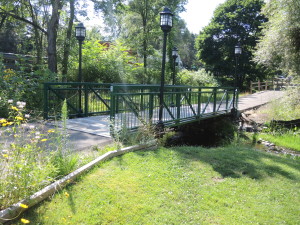
Part of the path from M-15 to the south Depot Park bridge is looking to be repaved, after a review by city engineers.
“The path by M-15 is slightly out of specifications for ADA,” said Gary Tressel, consulting engineer with Hubbell, Roth and Clark (HRC), at the July 25 City Council meeting. “We’re comfortable in saying to you, with a small modification at Main Street, the path is compliant – we don’t think it’s a problem.”
According to the Americans with Disabilities Act, walkways should have less than a five percent longitudinal, (downhill) slope, and less than two percent cross slope (from side to side), he said.
“Handrails are required when the slope exceed five percent,” Tressel said.
According to measurements made on July 20, the walkway exceeds those specs in two, 10-foot stretches.
The measurements include one longitudinal stretch of 5.5 percent, and a section with a cross slope of 2.2 percent.
Measurements taken in October of 2015 showed excessive slopes in eight downhill spots, as well as five side-to-side locations.
Both sets were taken using “smartlevel” tools. The readings from last year were incorrect and caused by defective engineering equipment, Tressel said.
“I can’t explain what happened with the October levels,” the city engineer said. “That level has been discarded.”
According to an HRC report to the city dated Oct. 12, 2015, “the pathway itself is built in compliance with ADA and Handicapped Standards and in compliance with the sidewalk design guidelines as published by AASHTO (American Association of State Highway and Transportation Officials), small sections of hand rail may be required to maintain the ADA accessibility (but certainly the entire length of this pathway does not) require even a handrail along it. Where those sections exceed five percent the city could add a handrail or a wedging of asphalt on either side to reduce the slope.”
A split-rail, unfinished, wood decorative handrail was installed on one side of the paved path. ADA requires handrails to be on both sides of the path, with gripping surfaces “free of sharp or abrasive elements and shall have rounded edges.”
In a July 20, 2016, report to the city, Tressel said the path complies with AASHTO rules.
“One location on the path amounts to .016 percent of variance from the two percent allowed and it is justified by the blending of the path into the Main Street sidewalk. The longitudinal slopes along the entire length of the path are in compliance with the AASHTO Guidelines,” he said.
According to the report, the path exceeds the five percent slope limit 30 feet from the bridge.
The report cited the guidelines regarding signs “at trail access points to identify steep grades, excessive cross slopes, narrow widths, or uneven surfaces, will help the users determine for themselves whether to use the path.”
Council member Eric Haven agreed, saying they should post a sign at the Main Street end of the pathway.
“My feeling is it’s somewhat intimidating for someone in a wheelchair, approaching the steep grade,” Haven said. “Compliant or not, my recommendation is we put a sign up.”
Mayor Joe Luginski said the city called for the pathway to be ADA compliant, and should see if the builder can be held to that.
Council member Al Avery said businesses and community members donated services to the project.
Planning and implementation work was completed by Clarkston DPW; and labor and materials were donated by a local asphalt company. Lights and plants were donated by Clarkston residents; the Optimist Club donated more than $5,000 for a security camera in the south end of Depot Park and other costs; Clinton River Watershed Council provided a grant of $5,000; and Hubble Roth and Clark donated more than $3,000.
“Donated or not, it needs to be fixed,” Luginski said. “We need to find out the cost, if there’s going to be a cost.”
Council member Sharron Catallo, who donated a light, said they should discuss it with them.
“If they say they can’t do that, we need to find out the cost,” Catallo said.
The bridge and walkway were built last year. The bridge was dedicated Sept. 7, 2015, in memory of the late Jeff Clark, brother of Bart Clark who along with his wife Diane donated $100,000 to the city for the project.
The review stemmed from calls, letters, and emails from members of the community over the past year. Cory Johnston, former city council member and registered professional engineer, and his wife Robyn Johnston presented their findings to the city council and planning commission.
“We are requesting the city address these deficiencies and the unfinished work at the south end of Depot Park immediately,” they said in a July 20 letter to City Council.


One Response to "More work for Depot Park path"